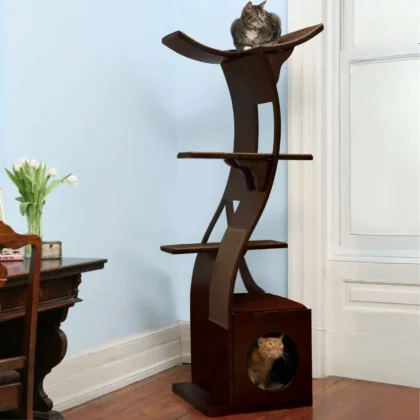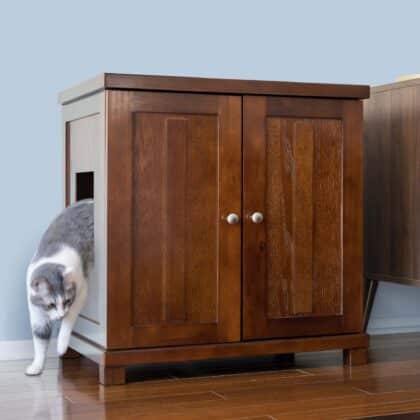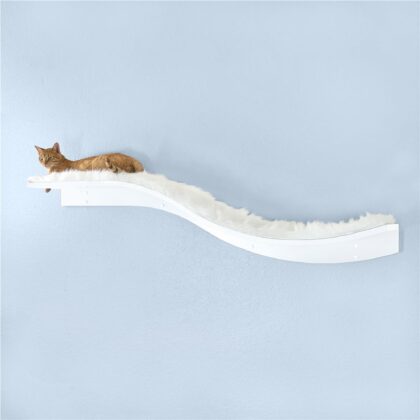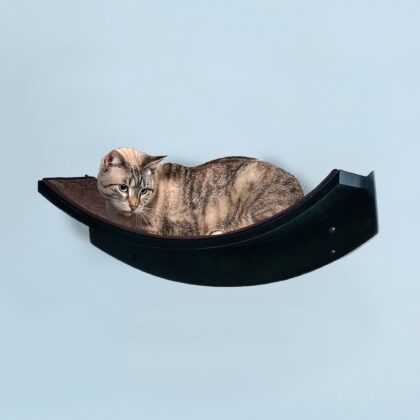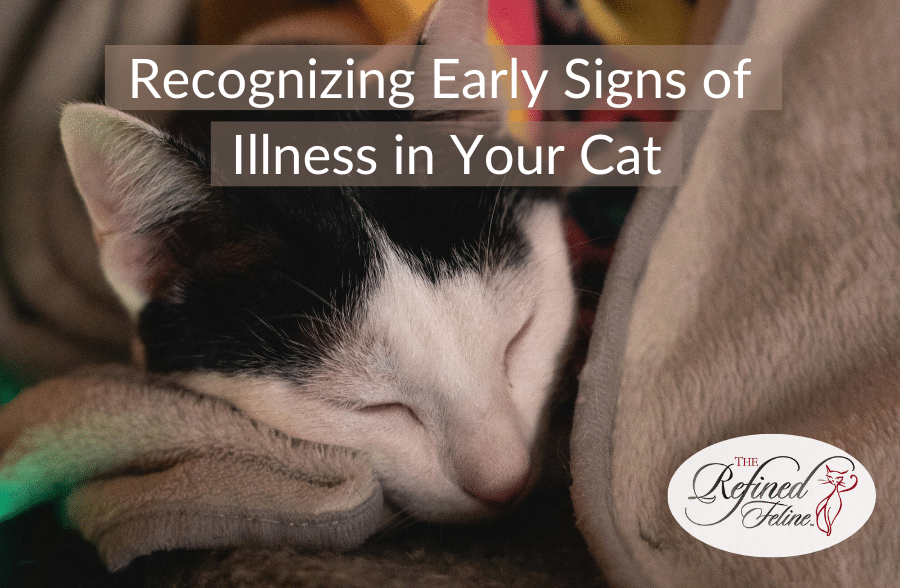
Recognizing Early Signs of Illness in Your Cat
Why Spotting Cat Illness Early Matters
Cats naturally hide weakness—an evolutionary trait that once protected them from predators but now makes health monitoring challenging for owners. Recognizing early signs of illness in your cat often means catching problems when treatment options remain simpler, less expensive, and more effective.
Most cats display subtle behavior changes long before physical symptoms become obvious. Many concerned cat parents miss crucial early warnings because felines instinctively mask vulnerability. Developing strong observation skills makes detecting changes possible before serious complications arise.
Setting up your home strategically—with smartly placed cat trees, beds, and litter boxes—allows you to notice when normal behaviors change. A cat suddenly avoiding a favorite perch or struggling to climb a previously loved cat tree sends important signals about possible health issues developing.
Key Behavioral Warning Signs of Cat Illness
Changes in Activity and Energy
Lethargy or no inclination to play ranks among the most common yet frequently overlooked warning signs your cat is crying for help. Healthy cats maintain consistent patterns with predictable energy peaks. When feeling unwell:
- Regular play sessions become shorter or disappear
- Jumping to favorite high spots decreases
- Normal cat trees suddenly seem challenging
- Usual patrol routes around the house change
- Sleep increases beyond typical patterns
- Standing or sitting positions replace active movements
Pay close attention to baseline behaviors to spot changes. Document specific examples like “no longer jumps to windowsill” or “sleeps extra hours versus normal routine” to share with your veterinarian.
Hiding Behaviors and Social Changes
Hiding increases dramatically when cats feel sick. While occasional alone time remains normal, extended periods away from family often indicate problems. Watch for:
- Spending time in unusual concealed locations
- Avoiding normally favorite resting spots
- Retreating when approached (atypical for your cat)
- Reluctance to emerge even for meals
- Choosing lower perches instead of high vantage points
Create monitoring opportunities with partially enclosed beds where observation remains possible without causing stress. Note duration of hiding episodes and whether eating occurs during seclusion periods.
Litter Box Habit Changes
Improper use of litter boxes provides critical early warnings about urinary, digestive, or mobility issues. Monitor for:
- Polyuria (increased urination frequency)
- Reduced urination volume
- Straining without producing waste
- Crying while using the box
- Eliminating outside the box despite clean conditions
- Blood in urine or stool
- Changed stool consistency
- Standing in box without eliminating
Never punish elimination problems—document patterns, frequency, appearance, and associated behaviors for your veterinarian. Consider adding easily accessible boxes if mobility appears compromised.
Changes in Grooming Patterns
Decreased grooming signals pain, depression, or oral problems. Conversely, excessive grooming may indicate skin irritation. Look for:
- Matted or oily coat (especially in long-haired breeds)
- Dandruff or skin flakiness
- Bald patches from overgrooming
- One-sided grooming (may indicate pain)
- Complete grooming cessation
- Hair loss or skin irritation patterns
Gently examine areas with grooming changes for wounds, parasites, or painful spots. Record patterns and consider whether environmental changes coincided with altered habits.
Appetite and Drinking Changes
Loss of appetite rarely happens without cause in cats. Pay attention to:
- Approaching food but not eating
- Sniffing meals then walking away
- Accepting treats but refusing regular food
- Dropping kibble while eating
- Head-tilting or favoring one side of mouth
- Reduced dry food intake but accepting wet food
- Excessive thirst or decreased drinking
Track exact consumption using measured portions. Note preferences for certain textures or temperatures that might indicate dental pain or throat discomfort.
Physical Changes Signaling Health Problems
Face and Head Warning Signs
Many symptoms of a sick cat eyes reveal larger health issues:
- Pupils remaining dilated or constricted inappropriately
- Constricted or dilated pupils that differ between eyes
- Cloudiness or color changes in eye appearance
- Squinting or excessive blinking
- Discharge or crusting around eyes
- Third eyelid showing prominently
- Eye bulging or recession
Beyond eye changes, watch for:
- Rhinorrhea (nasal discharge)
- Sneezing or congestion sounds
- Bad breath beyond normal cat breath
- Drooling (unusual for most cats)
- Head tilting or shaking behavior
- Facial swelling or asymmetry
Photograph any abnormalities to track progression and share with veterinary professionals. Clean discharges gently with warm water on soft cloth.
Body Condition Warning Signs
Weight fluctuations signal numerous conditions:
- Weight loss (check weekly by feeling ribs/spine)
- Weight gain (particularly sudden abdominal swelling)
- Muscle wasting despite unchanged fat deposits
- Changed body posture or movement patterns
- Swelling in limbs or body regions
- Visible lumps or bumps developing
Weigh your cat regularly when possible or photograph from consistent angles weekly for comparison. Document rapid changes occurring over days rather than weeks.
Digestive and Elimination Problems
Vomiting and diarrhea indicate potential emergencies depending on frequency and accompanying symptoms:
- Vomiting episodes exceeding twice in 24 hours
- Projectile vomiting
- Vomiting containing blood or unusual colors
- Diarrhea persisting beyond 24 hours
- Black, tarry stool appearance
- Straining without producing waste
- Bloated or painful abdominal area
Record frequency, content, and surrounding behaviors for veterinary assessment. Clean accidents with enzymatic cleaners rather than ammonia-based products.
Respiratory Warning Signs
Breathing difficulties require immediate attention. Watch for:
- Open-mouth breathing (panting)
- Rapid breathing rate during rest
- Noisy breathing or wheezing sounds
- Shallow breathing patterns
- Coughing or gagging episodes
- Excessive swallowing motions
- Blue-tinged gums (medical emergency)
Count respiratory rate while the cat rests (normal: 20-30 breaths per minute). Document patterns and seek immediate care for labored breathing.
Setting Up Your Home for Better Illness Detection
Strategic Furniture Placement for Monitoring
Cat trees for small spaces serve dual purposes—enrichment plus health monitoring opportunities:
- Place beds at various heights to assess jumping ability
- Position cat trees where daily usage remains observable
- Create multiple resting options to detect preference changes
- Install wall shelves along common pathways to monitor mobility
Cat furniture for small spaces works perfectly as health assessment stations when positioned in frequently used rooms. Declining use often precedes obvious illness symptoms.
Litter Box Arrangements for Early Detection
Strategic litter box placement helps catch problems early:
- Use unscented, fine-grained litter to monitor output clearly
- Position boxes where regular content checking remains convenient
- Consider shallow-sided boxes for seniors or potentially arthritic cats
- Maintain multiple boxes to determine if avoidance affects specific locations
Feeding Station Setup
Food and water arrangements impact health monitoring:
- Elevated feeding stations reveal neck/back pain
- Separate food and water to track individual consumption
- Consider timed feeders that reveal missed meals
- Use measured portions to detect subtle appetite changes
How to Treat a Sick Cat Without Going to the Vet
While serious symptoms require professional care, minor issues sometimes allow home monitoring:
When Home Care Might Be Appropriate
Consider home observation when:
- Symptoms appear mild and recent (under 24 hours)
- Cat remains hydrated and somewhat active
- No breathing problems exist
- Temperature and gum color remain normal
- Symptoms improve rather than worsen
Creating a Recovery Space
Design a comfortable sick bay with:
- Quiet location away from household traffic
- Easy-to-clean surfaces for accidents
- Comfortable, washable bedding
- Nearby food, water, and litter access
- Slightly elevated resting options reducing effort
Supporting Hydration at Home
Maintain fluid intake through:
- Multiple water sources (bowls, fountains)
- Adding water to food
- Ice cubes in water to encourage interest
- Meat-based broths without onion or garlic
- Monitoring water consumption closely
When Immediate Veterinary Care Becomes Essential
Never delay professional treatment when noticing:
- Dying cat symptoms like collapse or extreme lethargy
- Breathing difficulties of any kind
- Prolonged vomiting or diarrhea episodes
- Inability to urinate despite attempts
- Seizures or neurological symptoms
- Trauma or sudden mobility loss
- Severe pain indicators
What Are 4 Signs Your Cat is Suffering That Demand Action?
While many symptoms warrant monitoring, four critical signs always demand prompt veterinary care:
- Breathing difficulties – Any labored breathing, panting, or extreme respiratory effort constitutes an emergency
- Complete loss of appetite exceeding 24 hours – Cats physiologically cannot sustain prolonged fasting
- Lethargy with unresponsiveness – Inability to rouse or extreme weakness signals critical illness
- Urinary blockage – Straining repeatedly without producing urine (especially concerning in male cats)
Reading Sick Cat Body Language
Cats communicate discomfort through subtle postural changes:
Pain Indicators in Feline Body Language
- Hunched posture with arched back
- Tucked abdomen appearance
- Low head carriage
- Squinted eyes
- Flattened ears position
- Tail tucked or lowered
- Rigid body tension
- Unusual stillness or statue-like posing
Stress Signals Accompanying Illness
- Pupil dilation beyond lighting requirements
- Whiskers pulled back against face
- Rapid breathing patterns
- Hiding under furniture rather than on elevated surfaces
- Increased vocalization or unusual sounds
- Aggression when approached (unusual for your specific cat)
- Sudden mood change from normal personality
Supporting Recovery with Cat-Friendly Spaces
Comfort Considerations for Healing
Help healing through environmental adjustments:
- Provide soft, washable bedding materials
- Offer multiple resting surfaces at different heights
- Maintain moderate, comfortable temperatures
- Reduce household noise levels
- Create low-effort access to essentials
Monitoring Tools and Techniques
Track recovery progress with:
- Daily weight checks when possible
- Food/water consumption logs
- Activity level notes
- Medication response documentation
- Regular gentle examinations of concerning areas
Common Questions About Cat Illness
How can I tell if my cat is unwell?
Watch for behavior changes first—reduced activity, appetite changes, altered grooming, hiding, or litter box issues. Physical symptoms like vomiting, breathing changes, or unusual postures typically follow behavioral changes. Compare current behaviors against your specific cat’s normal patterns rather than general cat standards.
How do cats act when they sense illness?
Cats instinctively mask weakness by seeking isolation, reducing movement, and hiding pain. Many select lower resting places, avoid jumping, decrease grooming, and show subtle posture changes. Some cats paradoxically become more affectionate when feeling unwell, which also warrants attention if unusual for your specific cat.
Can a sick cat heal on its own?
Minor issues like occasional hairballs or brief digestive upset often resolve naturally, but most illnesses require intervention. Cats possess high pain tolerance and strong survival instincts, sometimes appearing better while conditions actually worsen. Always consult a veterinarian for symptoms lasting over 24 hours or affecting vital functions.
What are the symptoms of a cat with a disease?
Disease symptoms vary widely but commonly include lethargy, appetite changes, weight fluctuations, hiding behavior, altered elimination, vomiting, diarrhea, breathing changes, increased thirst, grooming changes, and unusual vocalizations. The specific combination of symptoms helps identify particular conditions requiring treatment.
Should I isolate a sick cat from other pets?
Yes—isolation benefits both the sick cat and housemates. Separation prevents potential disease spread, reduces stress for the affected cat, and allows accurate monitoring of food, water, and litter box usage. Create a quiet, comfortable space with essential resources easily accessible during recovery periods.
Becoming skilled at identifying subtle illness indicators requires consistent observation and patience. Creating a home environment with strategic monitoring opportunities through thoughtful placement of cat furniture, feeding stations, and resting areas makes detection significantly easier. Remember that behavior changes almost always precede obvious physical symptoms—paying attention to daily patterns could save your cat from serious complications or extended suffering.
When uncertainty exists concerning symptoms, always consult with a veterinarian promptly. Document specific changes noticed, as detailed information proves invaluable for accurate diagnosis and appropriate treatment planning. With practice and attention, catching health issues early becomes second nature, potentially preventing minor problems from developing into major medical concerns.



